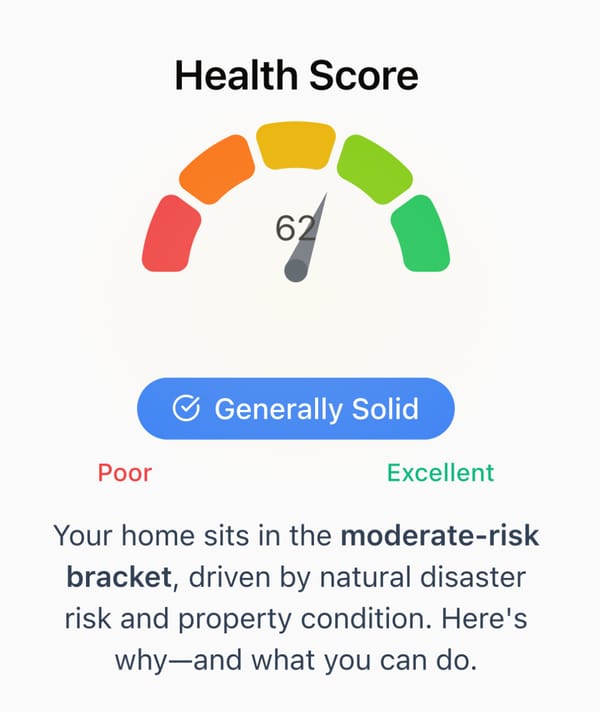Flood-Zone Mirage: How “X-Zone” Homes Still Rack Up $20k+ Losses

Snapshot
• 40 % of all NFIP flood-damage claims come from outside the high-risk (A / V) zones—mostly from the so-called “low-risk” X-zones. (Are You in a Flood Zone? What FEMA's 2024 Flood Map Mean for You)
• NFIP’s average paid claim topped $66,000 between 2016-2022; the median homeowner disaster grant was just $3,000. (Everyone Needs Flood Insurance | FEMA.gov)
• Federal flood maps update slowly; urban infill and climate-driven rainfall extremes are outrunning them by 5–10 years in many counties.
1. Why “Not in a Flood Zone” Is a Linguistic Trap
FEMA maps label moderate-to-low-risk areas as Zones B, C, or X. Lenders don’t require flood insurance there, so listings flaunt the phrase “No flood zone insurance required.”
Reality check:
| Claim Source | Share of NFIP Payouts |
|---|---|
| High-risk A/V zones | ~60 % |
| So-called low-risk B/C/X zones | ≥ 40 % (Are You in a Flood Zone? What FEMA's 2024 Flood Map Mean for You) |
Translation: four out of every ten checks FEMA cuts go to people who thought they were “safe.”
Want to see the data on your own address?
Run a FREE sample Property Insights report in 30 sec—no credit card, no spam.
2. Three Reasons the Maps Miss
- Static cartography vs. dynamic hydrology
Maps freeze a snapshot; beaver dams, new subdivisions, or wildfire-scorched slopes can reroute runoff within a single season. - 200-year benchmark delusion
Zone X (shaded) covers the 0.2 %-annual-chance flood. Climate records show formerly “500-year” events striking every 50–75 years in parts of the Midwest and Southeast. - Urban sheet flow
Impervious surfaces multiply; storm drains clog. The result isn’t riverine overflow but street-level flash flooding—unmapped but equally destructive.
3. Cost Delta: Insurance vs. Out-of-Pocket Reality
| Scenario | Before Flood | After Flood | Net Hit |
|---|---|---|---|
| Home w/ NFIP policy | $600 / yr premium (Zone X) | Average claim $66 k paid | –$600 (premium) |
| Home without policy | $0 | FEMA grant ~$3 k + SBA loan (interest) | –$63 k + debt ([Everyone Needs Flood Insurance |
Even a “cheap” $20 k remediation—drywall, flooring, appliance swap—lands squarely on uninsured owners.
4. Risk Rating 2.0: The Premium Shake-Up
FEMA’s new actuarial engine prices risk property-by-property, not zone-by-zone. Early data:
- Average premium change: ± $8–$20 mo for 96 % of policies, but high-value coastal X-zone homes can jump triple-digits. ([PDF] Risk Rating 2.0 | FEMA)
- Preferred-Risk Policies (cheap X-zone flat rate) have been phased out entirely. (| Flood Insurance Data and Analytics)
Expect lender scrutiny to follow—some banks already flag high-WLM (water-loss model) scores independent of FEMA maps.
5. How Property Insights 101 Quantifies “Invisible” Flood Threat
| Data Layer | What We Pull | Model Weight |
|---|---|---|
| FEMA FIRMs + Letter-of-Map Changes | Baseline zone + recent appeals | 20 % |
| NOAA Atlas 14 & local rain-gauge trends | Shifting intensity-duration-frequency curves | 25 % |
| Elevation & LiDAR surface flows | Street-level ponding depth at 100-yr storm | 25 % |
| NFIP claims density (de-identified) | Historical loss clusters | 15 % |
| Parcel-level mitigation (french drains, berms) | Credits for engineered protection | 15 % |
Output: Flood Exposure Score (FES) 0-100. Anything ≥ 70 triggers:
- Loss-scenario table (1 % vs 0.2 % annual chance events)
- Premium forecast under Risk Rating 2.0
- Mitigation ROI—e.g., $4 k perimeter drain yields expected $11 k avoided loss over 10 yrs.
6. Action Checklist
| Stakeholder | Must-Do |
|---|---|
| Buyers | Order an FES before waiving inspection; budget insurance into DTI ratios. |
| Inspectors | Photograph grading, downspouts, crawl-space moisture; flag if FES ≥ 70. |
| Agents | Disclose past water intrusion receipts—even in X-zones—to avoid post-close litigation. |
7. Takeaway
Flood water respects no ink on a federal map. Zone X is not a force-field; it’s a statistical comfort blanket that climate volatility is already ripping apart.
Property Insights 101 turns outdated contours into parcel-level probabilities—so you can plan, price, and protect before the basement turns into a riverbed.
That wraps our “Big Three” climate hazards series. Up next: decoding air-quality history—and why a single summer of wildfire smoke can slash HVAC life by 50%.
Want to see the data on your own address?
Run a FREE sample Property Insights report in 30 sec—no credit card, no spam.





